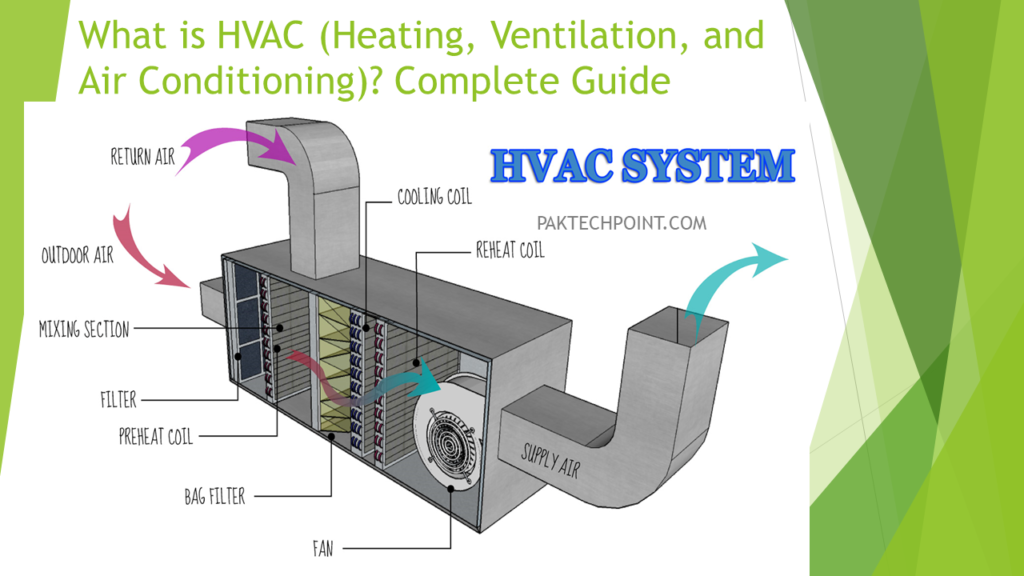HVAC stands for Heating, Ventilation, and Air Conditioning. HVAC (heating, ventilation and air conditioning) systems are designed to control the indoor climate conditions such as temperature, humidity and air quality in buildings such as residential homes, office complexes and factories. HVAC units aim to create an energy-efficient indoor environment while still offering comfort.

What is HVAC?
Each component of an HVAC system serves this function:
Heating (H):
Whilst HVAC systems primarily focus on cooling indoor spaces during hotter seasons, the heating component also serves to warm indoor spaces during the colder winter months. Heating sources commonly utilized include furnaces, boilers, heat pumps and electric heaters. Heat can be distributed using various methods, including forced air (ducted systems), radiant heating or baseboard heaters.
Ventilation (V):
Ventilation involves exchanging air between indoor and outdoor spaces to maintain high air quality levels. Air purifiers help remove indoor pollutants, odors and moisture while providing fresh outdoor air. Ventilation systems include fans, exhaust systems, and air exchange mechanisms.
Air Conditioning (AC or A/C):
Air conditioning systems play a pivotal role in keeping interior spaces cool during hot or humid conditions. Air conditioning systems, heat pumps and evaporative coolers can all help remove excess heat from indoor environments. Air conditioning systems distribute chilled air through ducts or ductless systems.
Key benefits and functions of HVAC systems include:
Temperature Regulation: HVAC systems help create comfortable temperatures within buildings regardless of outdoor climate conditions. Humidity Control: These devices regulate indoor humidity levels to provide comfort and avoid moisture-related problems like mold growth.
Air Quality: HVAC systems filter and purify indoor air by filtering out allergens, dust mites and pollutants that might linger inside a building.
Energy Efficiency: Modern HVAC systems are engineered for maximum energy efficiency, cutting down on both consumption and utility costs.
Zoning: Many systems allow for the option of zoning, meaning different rooms or areas can have their own individual temperature controls.
Year-Round Comfort: HVAC systems can offer year-round comfort through both heating and cooling capabilities, providing warmth in wintertime while cooling in summertime.
HVAC systems are essential in creating a healthy and comfortable indoor environment in residential homes, offices, factories, hospitals, and various other buildings. Proper design, installation and maintenance of HVAC systems is necessary for their optimal and effective operation.
- HVAC System Installation and Commissioning for Communication Building
- DRAINAGE PLUMBING WORK PROCEDURE FOR HVAC SYSTEM | METHOD STATEMENT
- ELECTRICAL & INSTRUMENTATION INSTALLATION WORKS FOR HVAC SYSTEM
- METHOD STATEMENT FOR HVAC REFRIGERANT PIPING WORK, PNEUMATIC PRESSURE & VACUUMING TESTING
- JOB SAFETY ANALYSIS FOR HVAC REFRIGERANT PIPING WORK
- JOB SAFETY ANALYSIS JSA FOR HVAC EQUIPMENT INSTALLATION
- HVAC MAJOR & MINOR EQUIPMENT INSTALLATION WORK METHOD STATEMENT
- METHOD STATEMENT FOR ELECTRICAL INSTALLATION WORKS FOR HVAC SYSTEM
- JOB SAFETY ANALYSIS FOR HVAC ELECTRICAL INSTALLATION
- HVAC SYSTEM INSTALLATION WORK PROCEDURE | METHOD STATEMENT
- INSTRUMENTATION INSTALLATION WORKS FOR HVAC SYSTEM METHOD STATEMENT
- JOB SAFETY ANALYSIS FOR HVAC INSTRUMENTATION INSTALLATION
- Commissioning and Functional Test for HVAC Control Panel | Method of Statement
- DDC BASED HVAC CONTROL PANEL SEQUENCE OF OPERATION (Substation Building)
- JOB SAFETY ANALYSIS OF HVAC COMMISSIONING AND FUNCTIONAL TEST
- HVAC MATERIAL STORAGE HANDLING AND PRESERVATION METHOD STATEMENT
- JOB HAZARD ANALYSIS FOR HVAC MATERIAL STORAGE HANDLING AND PRESERVATION
- HVAC Control System Fault Definitions
- HVAC System Functional Specification | Integrated Automation System
- HVAC Control System Fault Detection and Diagnostic
- HVAC Inspection Requirements 27-SAIP-01 Download
- HVAC Design and Calculation Software Free Download
- Design and Installation of HVAC Systems | SAES-K-001 Download
- Regulated Vendors List for HVAC Equipment | SAES-K-101
- SAES-K-003 – HVAC Systems for Communications Facilities & Data Centers
- Saudi Aramco Mechanical (HVAC) Code – SAES-K-100
- HVAC System Design Criteria
- HVAC Interface with Fire and Gas Detection Systems
- HVAC Hydronic (chilled water) system
- HVAC Duct Design
- HVAC Ventilation System | HVAC Exhaust Air System
- HVAC System Filtration
- HVAC Air System
- HVAC Design Conditions
- Fundamentals of HVAC Control Systems
- Electric Duct Mounted Heaters for HVAC System
- Humidifier For HVAC System | Air Conditioning Systems
- HVAC Chemical Filter Units
- HVAC Fans Selection Guide | Axial Fans | Ventilators
- HVAC Pump Selection and Types
- Fan Coil Unit System for HVAC
- HVAC International Codes and Standards
- Testing, Adjusting and Balancing TAB of HVAC System
- Supports, Anchors and Seals in HVAC Installation
- Types of Valves used in HVAC systems in Industry
- Water Specialties in HVAC
- HVAC Air Distribution Equipment
- Air Terminal Units in HVAC
- Pipe and Pipe fittings in HVAC
- Duct Insulation in HVAC | Insulate HVAC Heating and Cooling DuctWork
- Outside Air Filters | Proper Installation of HVAC Filters
- Sound Attenuators | Noise Reduction for HVAC Duct Systems
- Ductwork Accessories | HVAC Ductwork Design
- Heating, ventilation, and air conditioning HVAC Installation in Industries
- HVAC Ductwork Installation | Ductwork Design
- HEATING, VENTILATING AND AIR CONDITIONING DUCTWORK (HVAC)